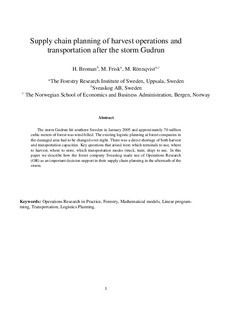| dc.contributor.author | Broman, Håkan | |
| dc.contributor.author | Frisk, Mikael | |
| dc.contributor.author | Rönnqvist, Mikael | |
| dc.date.accessioned | 2007-06-21T12:49:49Z | |
| dc.date.available | 2007-06-21T12:49:49Z | |
| dc.date.issued | 2006 | |
| dc.identifier.issn | 1500-4066 | |
| dc.identifier.uri | http://hdl.handle.net/11250/163851 | |
| dc.description.abstract | The storm Gudrun hit southern Sweden in January 2005 and approximately 70 million cubic meters of forest was wind felled. The existing logistic planning at forest companies in the damaged area had to be changed over night. There was a direct shortage of both harvest and transportation capacities. Key questions that arised were which terminals to use, where to harvest, where to store, which transportation modes (truck, train, ship) to use. In this paper we describe how the forest company Sveaskog made use of Operations Research (OR) as an important decision support in their supply chain planning in the aftermath of the storm. | en |
| dc.language.iso | eng | en |
| dc.publisher | Norwegian School of Economics and Business Administration. Department of Finance and Management Science | en |
| dc.relation.ispartofseries | Discussion paper | en |
| dc.relation.ispartofseries | 2006:16 | en |
| dc.title | Supply chain planning of harvest operations and transportation after the storm Gudrun | en |
| dc.type | Working paper | en |
| dc.subject.nsi | VDP::Landbruks- og Fiskerifag: 900::Landbruksfag: 910::Skogbruk: 915 | en |
| dc.subject.nsi | VDP::Samfunnsvitenskap: 200::Økonomi: 210 | en |
